Plot
The idea for the novel came from an incident outlined by Heinlein later:
When we were living in Colorado there was snowfall. Our cat—I'm a cat man—wanted to get out of the house so I opened a door for him but he wouldn't leave. Just kept on crying. He'd seen snow before and I couldn't understand it. I kept opening other doors for him and he still wouldn't leave. Then Ginny said, "Oh, he's looking for a door into summer." I threw up my hands, told her not to say another word, and wrote the novel The Door into Summer in 13 days. [2]
The novel opens in 1970 with Daniel Boone Davis, an engineer and inventor, well into a long drinking binge. He has lost his company, Hired Girl, Inc., to his partner Miles Gentry and the company bookkeeper, Belle Darkin. Darkin had been Dan's fiancée, deceiving him into giving her enough voting stock to allow her and Miles to seize control. Dan's only friend in the world is his cat, "Pete" (short for Petronius the Arbiter), a feisty tomcat who hates going outdoors in the snow.
Hired Girl, Inc. manufactures robot vacuum cleaners, but Dan had been developing a new line of all-purpose household robots, Flexible Frank, when Miles announces his intention to sell the company (and Flexible Frank) to Mannix Enterprises in which Miles would become a vice president. Wishing to stay independent, Dan opposes the takeover, but is outvoted and then fired as Chief Engineer. Left with a large financial settlement, and his remaining Hired Girl stock, he elects to take "cold sleep" (suspended animation), hoping to wake up thirty years later to a brighter future. The examining doctor at the cold sleep facility immediately sees that Dan has been drinking. He warns him to show up sober or not at all 24 hours later for the actual procedure.
After becoming sober, Dan decides instead to mount a counter-attack. First he mails his Hired Girl stock certificate to the one person he trusts, Miles' stepdaughter Frederica "Ricky" Virginia Gentry. Dan confronts Miles and finds Belle in Miles' home. Belle injects him with an illegal "zombie" drug, reducing him to somnolent compliance. Belle and Miles discover Dan's plans to go into cold sleep and have him committed, but to a different repository run by one of Belle's shady associates for the Mannix corporation.
Dan wakes up in the year 2000 with no money to his name and no idea how to find the people he once knew. What little money Belle let him keep went with the collapse of Mannix in 1987. He has lost Pete the cat, who fled Miles' house after Dan was drugged, and has no idea how to find a now middle-aged Ricky.
Dan begins rebuilding his life. He persuades Geary Manufacturing, which now owns Hired Girl, to take him on as a figurehead. He discovers that Miles died in 1972, while Belle has become a shrill and gin-sodden wreck. All she recalls is that Ricky went to live with her grandmother about the time Dan went into cold sleep. Her scheme with Miles collapsed, as the Flexible Frank prototype disappeared the same night she shanghaied Dan.
Dan finds Flexible Frank in use everywhere, filling many menial jobs once filled by people. It is called "Eager Beaver", made by a company called "Aladdin Auto-engineering." Dan can see that someone has taken his prototype and developed it. He is even more baffled to find that the patent is credited to a "D.B. Davis".
His friend Chuck at Geary lets slip that he once saw time travel working, in a lab in Colorado. At that point Dan finds that Ricky has been awakened from cold sleep and left Los Angeles for Brawley, California. Dan tracks her to Yuma, Arizona, where she was apparently married. When Dan looks at the marriage register, he finds that she married "Daniel Boone Davis". He immediately empties his bank account and heads for Colorado.
In Boulder, he befriends Dr. Twitchell, a once-brilliant scientist reduced to drinking away his frustrations. Eventually, Twitchell admits to having created a time machine of sorts. With the machine powered up, Dan goads Twitchell into sending him back to 1970, some months before his confrontation with Miles and Belle. He materializes in a Denver naturist retreat in front of a couple, John and Jenny Sutton, whom he befriends. The husband, a lawyer by trade, helps Dan cash in the gold he has brought back with him. In the future gold is no longer a coinage metal and costs a fraction of its value in 1970.
Working rapidly, Dan creates "Drafting Dan", an automated drafting machine, which he then uses to design "Protean Pete", the first version of Eager Beaver. He sets up a new corporation with the Suttons called "Aladdin Auto-engineering", returns to Los Angeles, and stakes out Miles' house on the fateful night. Watching himself arrive, he lets events unfold until Pete the cat emerges, then takes his own car and uses it to remove Flexible Frank and all his engineering drawings from Miles' garage.
Destroying the drawings and scattering machine parts across the landscape, he heads out to meet Ricky at her Girl Scout summer camp. Dan assigns his stock in Hired Girl to Ricky and suggests that she takes cold sleep when she is 21 so they can meet again. Ricky asks Dan if he will marry her after their cold sleep and Dan agrees. Dan returns to Los Angeles to use his original appointment for cold sleep, pleading that he lost the original paperwork.
With Pete in his arms, he sleeps for the second time until 2001. He greets Ricky, now twenty-one, when she awakes. They leave for Brawley to retrieve her possessions from storage, and then are married in Yuma. Setting himself up as an independent inventor, he uses Ricky's Hired Girl stock to make changes at Geary, settling back to watch the healthy competition with Aladdin.
Major themes
Some of Heinlein's stories, such as "'—All You Zombies—'" and "By His Bootstraps", feature time travel in which the protagonist re-creates himself using a time-travel paradox. This novel follows a similar theme, although the paradox is not central to the story. The idea recurs in the 1964 novel Farnham's Freehold , which hurls its protagonists into the future and then returns them to their own time, where they alter their destiny.
The novel is also post-apocalyptic, in that it takes place after a nuclear armed conflict. The United States was the clear victor, thanks to technologies that include the "cold sleep", which was used to maintain a large standing army that could be revived quickly and put into the field. The "zombie drug" used was a by-product of interrogation techniques. In the future time, "zombie recruiters" are apparently active, suggesting that the drug is widely used to recruit a form of slave labor.
It is mentioned that Washington, D.C., was destroyed, with the capital moved to Denver, Colorado, and there were also some hits on the East Coast and in Texas. However, the book in effect makes light of it. The United States rapidly recovers, refugees from devastated areas move to unharmed places, especially California, and the nuclear war leaves no lasting trauma. The 1984 book Warday by Whitley Strieber and James Kunetka takes up a limited nuclear attack in precisely the locations mentioned in Heinlein's book and depicts how hugely destructive it could be.
The early Heinlein biographer and critic Alexei Panshin, in his 1968 biography Heinlein in Dimension, took note of a controversial theme: "The romantic situation in this story is a very interesting, very odd one: it is nothing less than a mutual sexual interest between an engineer of thirty and a girl of twelve ('adorable' is Heinlein's word for her), that culminates in marriage after some hop-scotching around in time to adjust their ages a bit." [3] : 149–150
Reception
The novel "worried and bothered" John W. Campbell, who said "Bob can write a better story, with one hand tied behind him, than most people in the field can do with both hands. But Jesus, I wish that son of a gun would take that other hand out of his pocket." [4]
Science fiction writer and critic James Blish, writing in 1957, shortly after publication, criticized the lack of characterization of its hero Dan Davis, saying, "It is surely an odd novel that is at its best when the author is openly editorializing ..." — in this case about the "parity system of farm price supports, which in 2000 is applied to automobiles. ... Every other important subject of science fiction which Heinlein has examined at length has come out remade, vitalized and made the author's own property. It didn't happen here, for the first time in Heinlein's long and distinguished career — and not because Heinlein didn't have something to say, but because he failed to embody it in a real protagonist. Evidently, Heinlein as his own hero is about played out." [5] Floyd C. Gale was more positive in his 1957 review, comparing the book to The Sleeper Awakes and writing that "Heinlein paints a detailed picture of both civilizations, so evocative that 1970 emerges clearly in the reader's mind as the old days, and pretty primitive at that ... Of course you'll like Heinlein's latest". [6] The critic Alexei Panshin, writing in 1968, said that "as a whole, the story is thoroughly melodramatic but very good fun. ... It was as though Heinlein the engineer said, 'If I had the parts available, what little gadgets would I most enjoy building?' and then went ahead and built them fictionally. A good story." [3] : 78 After criticizing unrealistic science fiction, Carl Sagan in 1978 listed The Door Into Summer as among stories "that are so tautly constructed, so rich in the accommodating details of an unfamiliar society that they sweep me along before I have even a chance to be critical". [7]
In three Locus magazine readers' polls from 1975 to 1998, it was judged the 36th, 29th, and the 43rd all-time best science-fiction novel. [8]
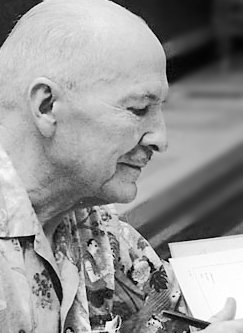
Robert Anson Heinlein was an American science fiction author, aeronautical engineer, and naval officer. Sometimes called the "dean of science fiction writers", he was among the first to emphasize scientific accuracy in his fiction, and was thus a pioneer of the subgenre of hard science fiction. His published works, both fiction and non-fiction, express admiration for competence and emphasize the value of critical thinking. His plots often posed provocative situations which challenged conventional social mores. His work continues to have an influence on the science-fiction genre, and on modern culture more generally.

Starship Troopers is a military science fiction novel by American writer Robert A. Heinlein. Written in a few weeks in reaction to the US suspending nuclear tests, the story was first published as a two-part serial in The Magazine of Fantasy & Science Fiction as Starship Soldier, and published as a book by G. P. Putnam's Sons on November 5, 1959.

Double Star is a science fiction novel by American writer Robert A. Heinlein, first serialized in Astounding Science Fiction and published in hardcover the same year. It received the 1956 Hugo Award for Best Novel.

Stranger in a Strange Land is a 1961 science fiction novel by American author Robert A. Heinlein. It tells the story of Valentine Michael Smith, a human who comes to Earth in early adulthood after being born on the planet Mars and raised by Martians, and explores his interaction with an eventual transformation of Terran culture.

Methuselah's Children is a science fiction novel by American writer Robert A. Heinlein. Originally serialized in Astounding Science Fiction in the July, August, and September 1941 issues, it was expanded into a full-length novel in 1958. The novel is part of Heinlein's Future History series of stories. It introduces the Howard families, a fictional group of people who achieved long lifespans through selective breeding.
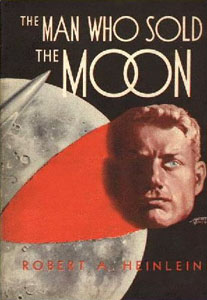
"The Man Who Sold the Moon" is a science fiction novella by American author Robert A. Heinlein, written in 1949 and published in 1950. A part of his Future History and prequel to "Requiem", it covers events around a fictional first Moon landing in 1978 and the schemes of Delos D. Harriman, a businessman who is determined to personally reach and control the Moon.

Time Enough for Love is a science fiction novel by American writer Robert A. Heinlein, first published in 1973. The book made the shortlist for the Nebula, Hugo and Locus awards for best science fiction novel of that year, although it did not win. It did win a retrospective Libertarian Futurist Society award: the Prometheus Hall of Fame award for 1988.

The Rolling Stones is a 1952 science fiction novel by American writer Robert A. Heinlein.
Reginald Bretnor was an American science fiction author who flourished between the 1950s and 1980s. Most of his fiction was in short story form, and usually featured a whimsical story line or ironic plot twist. He also wrote on military theory and public affairs, and edited some of the earliest books to consider SF from a literary theory and criticism perspective.

Joan D. Vinge is an American science fiction author. She is known for such works as her Hugo Award–winning novel The Snow Queen and its sequels, her series about the telepath named Cat, and her Heaven's Chronicles books. She also is the author of The Random House Book of Greek Myths (1999).
The Unpleasant Profession of Jonathan Hoag is a science fantasy novella by American writer Robert A. Heinlein. It was originally published in the October 1942 issue of Unknown Worlds magazine under the pseudonym of "John Riverside". The novella also lends its title to a collection of Heinlein's short stories published in 1959.
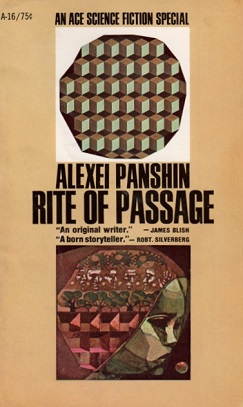
Rite of Passage is a science fiction novel by American writer Alexei Panshin. Published in 1968 as an Ace Science Fiction Special, this novel about a shipboard teenager's coming of age won that year's Nebula Award, and was nominated for the Hugo Award for Best Novel in 1969.
Jubal Harshaw is a fictional character featured in several novels by Robert A. Heinlein, most prominently 1961's Stranger in a Strange Land. He is described as: "Jubal E. Harshaw, LL.B., M.D., Sc.D., bon vivant, gourmet, sybarite, popular author extraordinary, neo-pessimist philosopher, devout agnostic, professional clown, amateur subversive, and parasite by choice."

Variable Star is a 2006 science fiction novel by American author Spider Robinson, based on the surviving seven pages of an eight-page 1955 novel outline by the late Robert A. Heinlein. The book is set in a divergent offshoot of Heinlein's Future History and contains many references to works by Heinlein and other authors. It describes the coming of age of a young musician who signs on to the crew of a starship as a way of escaping from a failed romance. Robinson posted a note on his website in 2009 noting that his agent had sold a trilogy of sequels based on the novel and its characters.
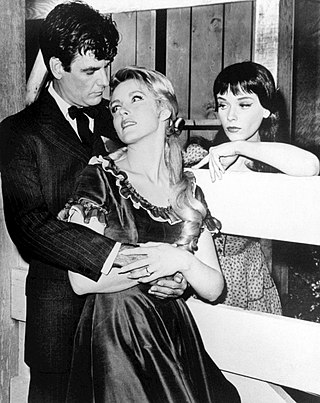
"Jess-Belle" is an episode of the American television science fiction and fantasy anthology series The Twilight Zone. In this episode, a young woman, whose name sounds like "Jezebel", spurned by the man she loves, becomes a witch in order to make him love her.
The Heinlein juveniles are the science-fiction novels written by Robert A. Heinlein for Scribner's young-adult line. Each features "a young male protagonist entering the adult world of conflict, decisions, and responsibilities." Together, they tell a loosely connected story of space exploration. Scribner's published the first 12 between 1947 and 1958, but rejected the 13th, Starship Troopers. That one was instead published by Putnam. A 14th novel, Podkayne of Mars, is sometimes listed as a "Heinlein juvenile", although Heinlein himself did not consider it to be one.
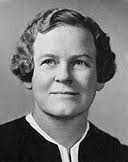
Alice Dalgliesh was a naturalized American writer and publisher who wrote more than 40 fiction and non-fiction books, mainly for children. She has been called "a pioneer in the field of children's historical fiction". Three of her books were runners-up for the annual Newbery Medal, the partly autobiographical The Silver Pencil, The Bears on Hemlock Mountain, and The Courage of Sarah Noble, which was also named to the Lewis Carroll Shelf Award list.
Advent:Publishers is an American publishing house. It was founded by Earl Kemp and other members of the University of Chicago Science Fiction Club, including Sidney Coleman, in 1955, to publish criticism, history, and bibliography of the science fiction field, beginning with Damon Knight's In Search of Wonder.

Doctor Sleep is a 2013 horror novel by American writer Stephen King and the sequel to his 1977 novel The Shining. The book reached the first position on The New York Times Best Seller list for print and ebook fiction (combined), hardcover fiction, and ebook fiction. Doctor Sleep won the 2013 Bram Stoker Award for Best Novel.

The Door into Summer is a 2021 Japanese science fiction film directed by Takahiro Miki and starring Kento Yamazaki, Kaya Kiyohara, Naohito Fujiki, Natsuna, and Hidekazu Mashima. Based on Robert A. Heinlein's novel of the same name, it was released on June 25, 2021.















